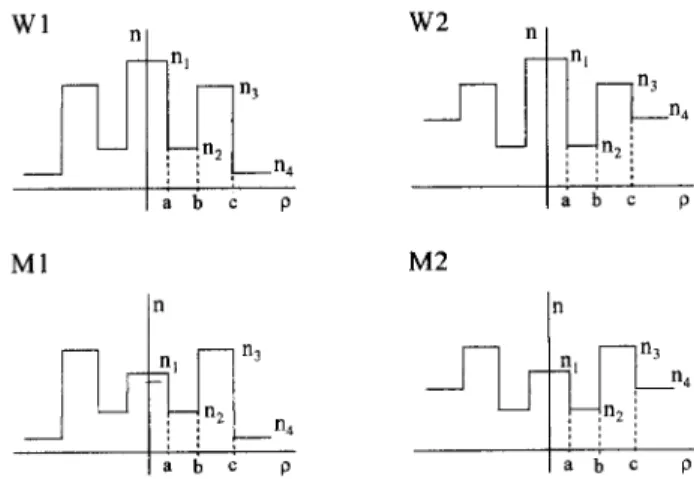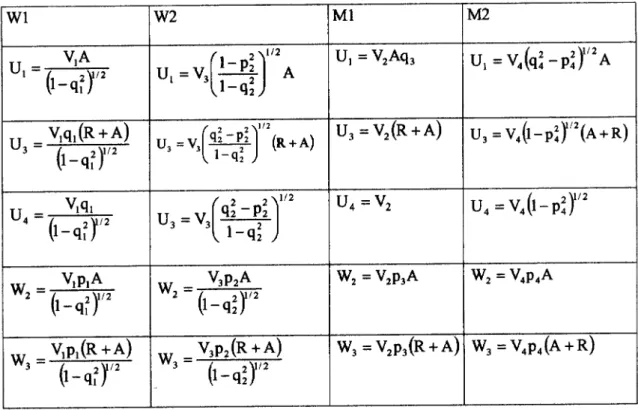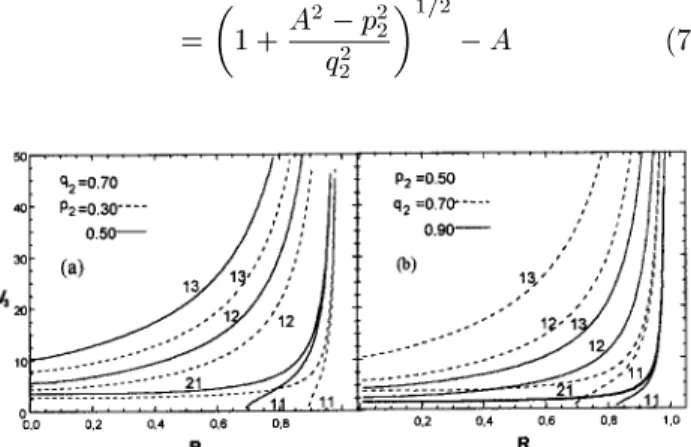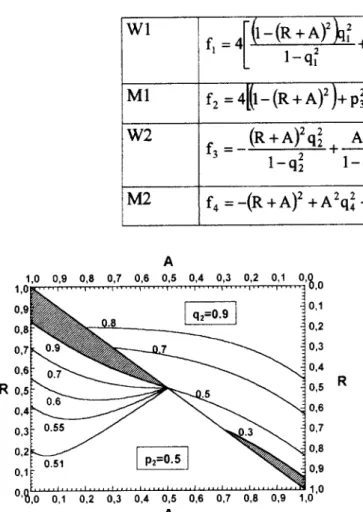Analysis of Cut-o Conditions for Coaxial Fibers
Humberto Filomeno da Silva
Departamento deFsia,CentrodeCi^enias ExataseTenologia
UniversidadeFederaldoMaranh~ao,Av. dosPortugueses,S/N
CampusdoBaanga,SaoLus,MA,Brazil-CEP65080-042
and Frederio Dias Nunes
Departamento deEletr^onia eSistemas,Centrode Tenologia
UniversidadeFederaldePernambuo
CaixaPostal7800, 50711-970,Reife,PE,Brazil
Reeivedon21June,2000. Revisedversionreeivedon20September,2000
Thispaperreportstheanalysisofmodalnormalizedfrequenyut-oofoaxialbershavingfour
dieletri layers. The ut-ourvesare obtained for four dierent strutures and several modes
as afuntionof the several parametersof the bers (refrativeindexand layerdimension). The
alulation is done using a transendental equation obtained in this work. The analysis pays a
speialattentiontothefundamentalmodeHE
11
showingthatfortwostrutures(W1andM1)the
normalized frequenyalways is null as is the ase of thestandard rodbers. For the other two
strutures(W2andtworegions), thenormalizedfrequenymaynotbenull,dependingontheset
ofvaluesoftheberparameters. Forthislastase aloidiagramisobtainedshowingtheregions
where the normalized frequeny is equalto zero and dierent from zero for several sets of ber
parameters. From the transendental equation, we have anexpression to alulate the urve of
separationbetweenthesetworegions.
I Introdution
CozensandBououvalas[1℄introduedanewstruture
ofoptialbershavingfourdieletrilayerswithwhih
ithasbeenpossibletodevelopdierentdeviessuhus
sensorsandspetrallters[2℄. Nunesetal[3℄have
pub-lished,forthersttime,adetailedtheoretialstudyof
fourdierentstruturesofoaxialbers. The
transen-dentalequationsforeahstruturewereobtainedforall
the rangesofphysiallyaeptable valuesof the
ee-tiverefrativeindex. Thisworkbringsomplementary
resultsto those ofRef. [3℄, beingfousedonthe
anal-ysisof theut-obehaviorofthestruturesW andM
[3℄. Theirrefrativeindexprolesareshownin Fig. 1
and, asindiated,bothstruturesW andMhavebeen
sub-lassiedas1and2.
The struture Wl and been used to manufature
spetral lters [2℄ with promising harateristis for
optial ommuniations and dispersion ompensating
ber [4℄ with large negative dispersion oeÆient D
for the fundamental mode. For example, the lters
aremadewithbertapersanditsphysialbehavioris
mainlydesribedusingperturbativetheory,loalmode
HE
11
andHE
12
. WiththeLMapproahitsisseenthat
theouplingbetweenHE
11
andHE
12
isafundamental
parton thedeviedesription. However,ouplingwill
onlyour if both modes exist. If one of them is
un-der the ut-o ondition, no oupling an our and
thedevieisunabletooperateshowingtheneessityof
understandingtheut-oonditions.
Theut-oonditionforonemodeisdependenton
theberparametersandlightwavelength. Inthe
spe-i ase of W oaxial bers with four dieletri
lay-ers,there areseven parameterstobeonsidered: four
values of refrative index and three dimensions (Fig.
1). These parametersarereduedto fouraordingto
whihtheut-oonditionsareanalyzed. ThevaluesV
of ut-onormalized frequenieare alulatedsolving
atransendentalequationthatwehaveobtainedandis
giveninsetionIII.Theresultsshowthatintheaseof
thestrutureW2andM2thefundamentalmodehasa
nonvanishingV,ontrarytothestrutureW1andM1
II Mathematial approah
The propagation harateristi of a oaxial ber an
bedesribedusing the well-known LPapproximation.
This is the approah that we use in this work and in
thissetionwepresentabriefdisussionof theresults
widely detailed in Ref. [3℄. The modal wavefuntions
willbethosegivenby
(;;z)='(;)exp(iz) (1)
where maybeE
y orE
x
,dependingonthehoie
be-tweenthetwopossiblelinearly polarized LPsolutions
[3℄,zisthediretion ofpropagationand isthe
prop-agationonstant. Ineq. (1), '(;)isgivenby:
'(;)=R ()
os(m)
sin(m)
; m=0;1;2::: (2)
where is theazimuth angle and m is the parameter
thatdenes theazimuthLPmodeorder. Thesolution
insineorosinefollowsfromthehoieofpolarization
[3℄. R () is the transverse solution given as a
ombi-nation of the well known Bessel and Modied Bessel
funtions of rst and seond lasses. In eah region,
an appropriate ombination of Bessel funtions is
re-quired to math the onditionsof onvergene that is
dependentontherangeofthemodaleetiverefrative
index. With this approah, transendental equations
[3℄ are obtained for eah struture and they desribe
the bers ompletely. For the strutures W1 and M1
the transendental equation is that orresponding to
N
e
(eetiverefrativeindex) within therange(n
2 ;n
4 )
[3℄. Forthestrutures W2andM2 thetransendental
equation isthat orrespondingto N
e
within therange
(n
1 ;n
4 )[3℄.
Figure1. Coaxialoptialbersprolesforthestrutures
W1,W2,M1andM2.
Table1-Parametersofeq.(3)
III Cut-o ondition
Theut-oonditionforanymodeoftheoaxialber
that weare analysingours when its eetive
refra-tive indexN
e
equalsto n
4
. Followingthis, theut-o
onditionforallbersanbeimposingmakingNe=n4
in the arguments of the Bessel funtion of the
orre-spondingtransendentalequations. Bydoingso,some
problems our beause the modied Bessel funtion
K
m (W
4
) divergesfor verysmall valuesof W
4
. These
problems an be overome using the small argument
approximation in the transendental equation for the
eetive refrative index and easy mathematial
ma-nipulations, theut-ofrequenyanbealulatedby
solvingthefollowingtransendental equation:
2`J
` (U
4 ) U
4 J
`+1 (U
4 )
2`J
` (U
4 ) U
4 Y
`+1 (U
4 )
(ADBC)
=(E
1 DE
2
B); `=0;1;2;::: (3)
whereU
4
,A,B,C,D,E
1 andE
2
areparametersgiven
in theTables1,2and 3. InTable2,A and Rare
de-ned as: A= a
, R=
b a
turesW1andM1whiletheplussignto thestrutures
W2 andM2. The numeri solutionsof theeq. (3) for V
i
(i=1,2,3,4) are shown and disussed in the setion
IV.
Table2-Besselfuntion"sargumentswhereV
1 =k
0 (n
2
1 n
2
3 )
1=2
;V
2 =k
0 (n
2
3 n
2
4 )
1=2
;V
3 =V
1 and
V
4 =k
0 (n
2
3 n
2
2 )
1=2
:
A speial attention is givento themodeHE
11
be-ause itisthemostommonexitedmodeoftheber
in pratialappliations. As wewill showin the next
setion,eq. (3)justadmitssolutionfordisretvaluesof
V
i
(i=1,2,3,4)foraertainvalueof`. Then,thestudy
of eq. (3) assuming` =0 andlose to V
i
=0, allows
to determine when the fundamental mode presents a
ut-odierentfrom zero.
For this purpose, we will dene the funtion G as
the dierene between the right and left sides of eq.
(3). Following the analysis of Safaai-Jazi et al [6,8℄,
we will use the ondition ` =0 and V
i
! 0 in G. In
thelimitwhere V
i
issmall,allBesselfuntions present
expansions[7℄forsmallarguments.
SubstitutingtheseexpansionsinG,makingthe
ne-essarymanipulationsandmaintainingthetermsof
lin-eal orderinV weobtains:
G=f
i V
i
; for i=1;2;3;4 (4)
where f
i
isa funtion that depend on theparameters
and kind of the oaxial ber under analysis, and are
dene when V
i
is lose to zero. When V
i
tends to 0,
G should tend to zero for V
i
to be a solution of eq.
(3). Forthe bers W1and M1, f
i
(i=1,2) in eq. (4)
is always positive and dierent from zero for any
val-uesof the bersparameters. ForGto be nullin this
limitwe must always have V
i
= 0: In these ases the
fundamental modehasanullut-o.
Thesituationis dierentforbersW2and M2. In
thelimitV
i
!0(i=3,4),Ganbezerousing the
on-dition f
i
= 0 for these bers. In this ase V
i
anbe
dierentfromzero. Thisonditionallowstodetermine
the relationship between the parameters of the ber
startingfrom whereV
i
beomedierentfromzero.
IV Results
We rstpresent the resultsof an important ase
or-responding to the ut-o normalized frequeny of the
fundamental mode. As is well known in onventional
ore-lad bers, the mode HE
11
always has a ut-o
For the strutures W2 and M2, f
i
(i=3,4) may
hange itssignaldepending ontheset ofvaluesofthe
bersparameters. Then f
i
=0 is the limit ondition
for G= 0in eq. (4) with V
i
6= 0(i=3,4). Therefore,
dependingonthevaluesofthedimensionalparameters
and of the refrative indexes, the fundamental mode
has V
i
=0or V
i
6=0. This behavioris alreadyfound
inthree layersbersasreportedbySafaai-Jazi[6℄and
Mahmaudetal[9℄.
The limit equations obtained in this work for the
strutures W2 and M2 an be heked-upin thease
some limit strutures. For example, making a = 0
(A=0), theoaxialberW2 isreduedto the
stru-turestudiedbyMahmaudetal[9℄,asshowninFig2.a.
Theritialvalueb/isobtainedin this workmaking
A = 0 in the equation f
3
= 0 for the W2 struture
givenin theTable(4):
b = n 2 3 n 2 4 n 2 3 n 2 2 1=2 (5)
ThisresultreproduesthatofRef. [9℄. Mahmaudetal
showthatforb/largerthanthevaluesuppliedbythe
eq. (5),thefundamentalmodepresentut-odierent
fromzero.
Figure2. LimitstruturesfortheberW2.
Bymaking b = (R = 0) in the equation f
3 = 0
fortheW2struture,wereprodued theresultsofthe
struture studied by Adams [10℄, shown in Fig. 2.b.
Theritialvaluea/obtainedisthisworkis:
a =p 2 = n 2 4 n 2 2 n 2 1 n 2 2 1=2 (6)
thatisinagreementwithRef. [10℄. WewillanalyzeV
i
(i=1,2,3,4)fordierentmodesasfuntionoftheother
parameters of the ber. This analysis will be made
through numerialsolution of eq. (3) for the referred
struture. In order to avoid exeeding numberof
g-ures,wehavehosenafewonvenientmodesandV
i is
studied as afuntion of the parameterR for dierent
setsoftheremainingparameters.
IV.1 W1 struture
Fig. 3(a,b)showV
1
asafuntion ofRfordierent
modes HE
11
(n=2,3) and HE
21
for thestruture W1.
Asitiswellknown,themodeHE
21
isthehigherorder
modenexttoHE
11
permittedtopropagateinstandard
bers[8℄. TheparameterR inthisgurehasvaluesin
the range [0,1-A℄. In the extreme values of the R the
W1 strutureis reduedto a threeregion double lad
struture.
The W1 struture always has a vanishing ut-o
frequenyforthefundamentalmodeaordingto
argu-ments presented after the dedution of eq. (4). For
other modes, V
1
has non-vanishing values whih
in-rease for inreasing R and order modes, presenting
quasi-osillatorybehavior. Theseosillationswerealso
reported by Bououvalas et al [11℄ for a oaxial ber
with n 1 =n 3 and n 2 =n 4
. Beause the oaxialber
hasmanyparametersitisnoteasytoseparatetheir
spe-iinueneontheV,behaviorshowninFig. 3(a,b).
Inordertoexplaintheosillationswesuggestthatthis
behaviorisausedbytheompetitionbetweenthetwo
oupled substrutures that ompose the oaxial ber.
As disussed in Ref. [11℄, the oaxialberis a
stru-tureformedbytwooupledstrutures,namelyrodand
tube. ForsmallR values,therod harateristitends
tobedominantduetoitsstrongeronnement
hara-teromparedtothetubestruture. Ontheotherhand,
in therangewherethetubeharateristiis dominant
(large R values), V, inreaser faster. For R between
these extremevaluesitis notlearwhodominatesthe
ompetition. InthisintervalofR ,V
1
presentan
inter-mediarybehaviorbetween thetwolimitingsituations.
Fig. 4 shows the behavior of the onnement fators
(between the energy ontained in ertain layer of
re-frativeindex andthe total energy),veryloseto the
ut-o onditions for the modes HE
12
and HE
13 . In
these graphs, g
1
is the onnement fatorof the ore,
g
2
istheonnementfatoroftheregionofthe
refra-tiveindexn
2 ,g
3
istheonnementfatoroftheregion
of therefrativeindexn
3
, F =1 (g
1 +g 2 +g 3 )and
ut-o is the normalized ut-o urve. These graphs
show that, if the ut-o urve is approximately
on-stant, all frations of energy ontained in eah layer
areapproximatelyonstant. WepointoutthattheV
1 ,
urvesorrespondingtomodesHE
21
andHE
12 havea
rossingpoint,asobservedin Fig. 3b. Thisisalso
ob-served in the struture analyzedby Bououvalaset al
[10℄andindiatesthatforsomesetsofberparameters,
themodeHE2,isnolongerthelowestmodesubsequent
Fig. 3ashowsthatsmallvaluesofp
1
takethelargest
valuesofV
1
forR>0:1. Itiseasytoseethatlower
val-uesofp
1
,withonstantq
1
,orrespondto lowervalues
ofn
2
resultinginalargestep(n
1 n
2
)inthegapregion
andasaonsequene,weakeronnementthatleadsto
highervaluesof V
1
:ForR<0:1, theut-ofrequeny
doesnothangefordierentvaluesofp
1
beause
pra-tiallydoesnotexistaregionintheberorresponding
totherefrativeindexn
2
. Thus,thereisnosigniant
hangeonV
1
whenp
1
ismodied. Thesamebehavior
ours inFig. 4b,butin thisase,V
1
is smallerin the
whole rangeofR beausetheextensionof thenuleus
islarger,inreasingtheonnementofthemodes.
Figure 3. Coaxial berut-o frequenies for the modes
12, 13 and 21for dierent values of q
1 and p
1
inthe W1
struture.
Figure4. ConnementfatorfortheW1struturenextto
theut-owithA=0.01. Theut-ourveisthenormalized
ut-ourve. (a)HE12mode. (b)HE13mode.
Theanalysesarriedouttounderstandthevariation
ofp
1 andq
1
anbesummarizedwiththefollowingrule:
the modalonnementinreasesintheproximityofthe
ut-oondition(V
1
dereases)ifthe refrativeindies
satisfy the following ondition n
1 = n 2 = n 3 .
Apply-ingthisruletoanalyzethegraphsofthestrutureW1
allowsustounderstandthetendsoftheurves.
IV.2. M1 Struture
TheM1struturehasabehaviorsimilar tothatof
the W1 struture and the same kind of analyses an
bedoneforthisstruture. It isaremarkablefat that
therulevalidtodesribethebehaviorofV
1
fortheWl
strutureisalsovalidtodesribethebehaviorofV
2 for
the M1struture. A omment isthat,for asmall rod
dimensio, V
2
is basially independent of the
parame-ter q
3
. This ours when A isverysmall andbeause
n
1 <n
3
. Then, theinuene ofthe rod region onthe
IV.3. W2 struture
Theut-ovaluesofV
3
forthestrutureW2is
pre-sented in Fig. 5 (a,b). This struture presents very
dierentbehaviorinomparisonwiththoseofthe
stru-turesW1andM1. Thestrutureisfreeofosillations,
presentingastrongdependeneonRwhenthis
param-eter approah the limiting values R = 1 A. This
behaviorindiatesthatareduedompetitionbetween
thetwosubstruturesoursandthetubesubstruture
is dominant in almost all range of R . Also, no
ross-ingpointisobservedbetweentheV
3
urvesofdierent
modesasistheaseoftheW1andM1bers. Thesharp
dependene oftheut-onormalizedfrequenyforthe
strutureW2onRindiateaweakmodalonnement
thatisassoiatedwiththehighrefrativeindex ofthe
lad region (n
4 > n
2
). Another great dierene
be-tweenthestrutureW2andtheothersalreadystudied
refersto the behavior of the fundamental mode. For
thismode,aritialvalueofRexistsabovewhihV
3 is
dierentfrom zero. Thisritial valuedepends onthe
setoftheberparametersbeingfound, imposingthat
f
3
intheTable4isnull. Then,
= 1+ A 2 p 2 2 q 2 2 1=2 A (7)
Figure5.Coaxial-berut-ofrequeniesforthemodes11,
12, 13 and 21 for dierent values of q
2 and p
2
in the W2
struture.
Using theequationf
3
=0for thestrutureW2, it
is possible to obtain in the planeRA thelous
di-agramof theregionswherethefundamental modehas
V
3
= 0and V
3
6= 0forthe struture W2. Theresults
areshownin Fig. 6. Theshadedregionsin thisgure
indiatewhereV
3 6=0:
Fig. 5ashowsthatinreasingvaluesofp
2
with
on-stantvalueofq
2
,inreasethevaluesofV
3
. Byobserving
thedenition ofp
2 andq
2
in Table 3it anbe
under-stood that inreasing the value of p
2
keeping q
2
on-stant,meanshighervaluesof(n
4 n
2
). Thissituation
impliesasmalleronnementof modes. Onthe other
hand,q
2
variesandp
2
ismadeonstantinFig. 5b. The
higherthevalueofq
2
,thelowerthevaluesofV
3 ,an
ef-fetopposite of inreasing p
2
asshown in Fig. 5a. In
thisase,inreasingvaluesofq
2 withp
2
onstantmeans
highervaluesofn
3
Table4-Funtionsf
1
foreahoaxialstruture.
Figure6. DelimitationurvesbetweenV
3
=0and V
3 6=0
(shaded)forthefundamentalmodeoftheW2struture.
Table3-Denitionofpandqfortheseveral
strutures.
When the radius of the nuleus inreases, the
be-havior of V
3
for the modes hange substantially, as
showsin Fig. 7. This resultwasobtainedfor A=0.20,
n
1
=1.4658, n
2
=1.444, n
3
=1.46 and n
4
=1.4587. The
modesHE
11
andHE
12
areveryloseforertainvalues
ofRwithV
3
onstantwhenR>0:5forthemodeHE
11 .
For themode HE
12
, twointervalsofonstantvariable
R exist. This behavior is justied when the study of
the dispersion urves is made [12℄. This study allows
toonludethatforertainvaluesofRtheresults
ob-tainedoftheW2limitstruturemakingn
1 =n
2 ,
dom-inatesthebehaviorofthewholestruture. Inthisway,
thedispersionurveofthestrutureW2alwaysbegins
in thesamevalueindiatingthat theut-o ondition
doesn'thange.
Figure7. Coaxial-berut-ofrequeniesofmodes11and
12withA=0:20andtherefrative indexitedinthetext
fortheW2struture.
IV.4 M2 struture
The M2 struture presents a behavior similar to
that ofW2. Thesamekindofanalysisis appliableto
thisstrutureandalsothefundamentalmodehas
non-vanishingut-onormalizedfrequenyabovearitial
value of R . The expression for the value of R above
whih theut-o onditionsof the fundamental mode
beomesdierentfrom zeroanbe established
impos-ingtheonditionf
4
=0inTable4. Then,
R=(1+A 2
q 2
+p 2
) 1=2
Afatthatdeservestobementionedhereisthe
in-dependeneofV
4 onq
4
,forsmallvaluesofA.Changes
in the value of q
4
while keeping p
4
onstant does not
produeanyeetonthevaluesofV
4
beausethevalue
ofA issmall. Changesin q
4
withp4onstantmeansa
variationof n
1
aordingto thedenition ofthese
pa-rameters givenin Table3. Therefore,for verynarrow
rodregion,theinueneoftherefrativeindexisalmost
nonexistent. ThisalsohappensfortheM1struture.
V Conlusions
This work presents results about the ut-o behavior
of four oaxial bers with four onentri layers. In
orderto alulatetheut-onormalizedfrequeny
nu-merially, we obtained a transendental equation for
the normalized frequeny V
i
(i=1,2,3,4) for the four
strutures. The results show that eah pair of
stru-tures W1/M1 and W2/M2 have a dierent behavior.
For the strutures W1 and M1, V
i
(i=1,2) shows an
osillatory harateristi behavior as a funtion of R
and the fundamental mode alwayshas V
i
=0. In the
aseofthestruturesW2and M2,V
i
(i=3,4)presents
a non-vanishing ut-o normalized frequeny for the
modeHE
11
,andthereisnoosillatorybehaviorofthe
modes. WefoundexpressionsfortheritialvalueofR
asfuntionoftheparametersoftheber,startingfrom
whihthefundamentalmodepresentsaut-odierent
from zero.
Aknowledgements
TheauthorsaknowledgeCNPqUniversidade
Fed-eraldoMaranh~ao,fornanialsupport.
Referenes
[1℄ J. R. Cozens and A. C. Bououvalas, Eletron. Lett.,
18,138(1982).
[2℄ S. Celashi, J. T. Jesus, D. Dini, A. Juriollo and R.
Arradi, Narrowband All-FiberSpetralFilters,
CPqD-Telebras,Campinas-SP.
[3℄ F.D.Nunes,C.A.S.Melo andH.F.daSilva,Applied
Optis,35,388,January(1996).
[4℄ F.D. Nunes, H. F.da Silvaand S. C.Zilio, Brasilian
JournalofPhysis,28,June(1998).
[5℄ J.D.Love,W.M.Henry,W.J.Stewart,R.J.Blak,S.
LaroixandF.Gauthier,IEEProeedings-J,Vol.138,
n5,Otober(1991).
[6℄ Ahmad Safaai-Jazi and Gar Lam Yip, IEEE
Transa-tionsonMirowaveTheoryandTehniques,Vol.
MTT-26,No.11,898-903,November(1978).
[7℄ M. Abramowitz, Handbook of Mathematial Funtions,
pp.355-433,DoverPubliations(1965).
[8℄ A.Safaai-JaziandG.L.Yip,RadioSiene,12,No.4,
603-609,July-august(1977).
[9℄ Samir F. Mahmoud and A. M. Kharbat, Journal of
Lightwave Tehnology, Vol. II, No. 11, 1717- 1720.
November(1993).
[10℄ M. J. Adams, An introdution to optial waveguides,
pp272,JohnWiley&Sons(1981).
[11℄ AC.Bououvalas,OptisLetters,10,No.2,February
(1985).
[12℄ H.F. Da Silva,DotorateThesis, IFSC-USP,August




